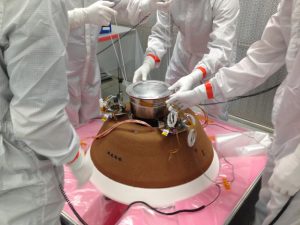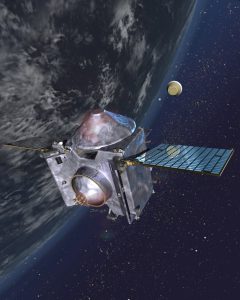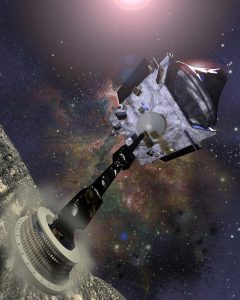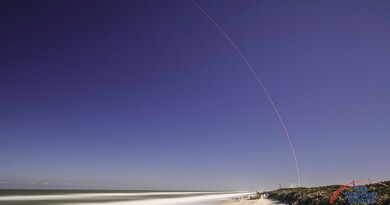Science Objectives of OSIRIS-REx
SEPTEMBER 8, 2016 CAPE CANAVERAL: An Atlas V rocket launched the OSIRIS-REx spacecraft on its way to rendezvous with a skyscraper-sized asteroid named Bennu. In six years, 11 months, and 27 days, a sample of Bennu will parachute into Utah. At that point, decades of science begin.

The sample return capsule will contain anywhere from 2 ounces to 4.4 pounds of Bennu. The material will be a mix of dust and gravel (up to 1 centimeter in size). By returning a portion of the asteroid to Earth, the science team will use room-sized instruments to analyze this ancient asteroid.
As part of the mission plan, 25% of the returned sample will be used for current analysis. Another 75% will be archived for use over the coming decades. The OSIRIS-REx team says that future generations will be able to analyze the sample from Bennu to "perform tests we haven't thought of, using equipment not been invented yet."

Extrapolating from Bennu to Other Asteroids
NASA has a planetary defense department on the lookout for asteroids that could one day impact the Earth. This team uses ground-based instruments to identify and characterize asteroids. This team has ground-based readings on Bennu. OSIRIS-REx maps Bennu with photographs and spectral imaging tools for almost two years. NASA compares their ground-based observations with new maps of Bennu. They will learn what adjustments to make to ground-based readings for other asteroids.
Quantifying the Yarkofsky Effect
Once scientists detect a near-Earth asteroid, they use Keppler Laws of Motion to predict where asteroids will be in the future. Models predict if the asteroid will strike the Earth. While Kepler's laws are great for planets, something else happens small bodies like Bennu.
Bennu spins once every 4.288 hours. The sun rapidly heats one side of Bennu. Bennu expels heat during a very short Bennu night. The heat radiating off of the night side of Bennu pushes Bennu off course ever so slightly. Since Bennu was discovered in 1999, it moved 109 km off from where Kepler's laws would expect.
Bennu crosses between the Earth and the Moon in 2135. Depending on how much the Yarkofsky effect keeps pushing Bennu, it has a 1-in-1400 chance of impacting Earth in the 2161 to 2191 time frame.
OSIRIS-REx will be measuring the asteroid thermal properties and the resulting acceleration and change in rotation state will lead to a better quantification of the Yarkofsky effect. This, in turn, will lead to better models of all near-Earth objects. On the one hand, this might definitively prove that Bennu is not a threat in 2161. Or, it might prove that Bennu has a much higher chance than 1-in-1400 of striking the Earth.
Mapping Bennu For a Future Diversion Mission
OSIRIS-REx will be mapping Bennu in order to find the best place to collect the sample. Those maps could come in handy if future Earth generations determine that Bennu is a threat. The 3-D mapping of Bennu will be critical to a diversionary mission in the year 2135. During launch week, NASA hosted a panel discussion on their study of asteroids that might one day wipe out life on Earth.
Fans of the 1989 movie Deep Impact recall Robert Duvall and the crew of the Messiah spacecraft. They were planning on detonating eight 5000 kiloton nuclear warheads 100 meters below the surface of their asteroid. Current science is quite different from the movie.
One NASA plan is to land on an asteroid, pick up a 10-ton boulder, and then move away from the asteroid. The spacecraft and 10-ten boulder would fly along side of the asteroid for an extended period. The gravitational pull of the boulder would be enough to alter the asteroid trajectory. This certainly isn't as dramatic as the 1989 movie. However, it is one of the two current theories of how to one day save Earth from an extinction-level event.

Collecting Organic Molecules
Bennu will provide a glimpse into the building blocks of life from the earliest times. Scientists theorize asteroids crashed into the early Earth depositing carbon-based molecules.
Do you recall that DNA has four letters? A, C, G, and T represent the four nucleotide bases of a DNA strand — adenine, cytosine, guanine, thymine. Those four letters encode 20 amino acids, which are strung together to create millions of different proteins. But - what if the asteroids that began life on Earth happened to have those four letters and other asteroids had different letters?
A DNA alphabet with six letters could encode as many as 216 possible amino acids. This could lead to the rise of completely different life forms. Since Bennu originated from a different area of the sky, scientists might discover a different genetic alphabet on Bennu.
Dr. Ken Kremer and Chirality Would be a Great Name for a Rock Band
Anyone watching the post-launch conference might have noticed Dr. Ken Kremer's question about chirality. Scientists have noticed that most amino acids on Earth are left-handed. Why? Did the asteroid that formed life on Earth pass through an ancient magnetic field that caused those early building blocks of life to favor the left-handed version?
Since Bennu originated from a different area, it might be loaded with a mix of left- and right-handed amino acids. Dante Lauretta said the team would proceed slowly. It would take some time after September 23 2023 landing of the sample before they could answer the chirality question.
Just imagine if the Bennu sample has a new genetic alphabet and right-handed amino acids. Science fiction will have a field day with superior beings made up of a six-letter genetic alphabet.

Stunning, full color photo book covering every east coast launch spanning 2014-2015, including the first-ever powered landing of a SpaceX Falcon 9 rocket.
More Info



